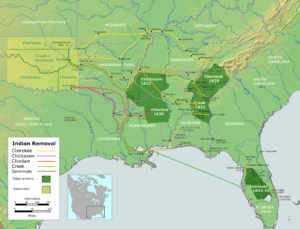Indian Removal Act facts for kids

The Indian Removal Act was a law passed in the United States in 1830. President Andrew Jackson signed it, making it an official law. This act gave the President the power to make Native American tribes move from their homes to new land west of the Mississippi River.
Not everyone in America liked this law. For example, Davy Crockett, a Congressman from Tennessee, was strongly against it. Some tribes agreed to sign treaties and move peacefully. However, other tribes, like the Cherokee Nation, fought against the government. In 1838, the Cherokee were forced to march west. This difficult journey is now known as the "Trail of Tears".
Contents
Why the Law Was Passed and Who Opposed It
The Indian Removal Act had strong support in the Southern states, especially in Georgia. Georgia was a very large state at the time and had disagreements with the Cherokee people over land. President Jackson hoped this law would solve these land problems.
Besides the "Five Civilized Tribes" (Cherokee, Chickasaw, Choctaw, Creek, and Seminole), other tribes like the Wyandot, Kickapoo, Potowatomi, Shawnee, and Lenape were also affected by this law.
The Indian Removal Act was very controversial. Many Americans supported it, but many others strongly opposed it. A lot of Christian missionaries spoke out against the law, including a well-known organizer named Jeremiah Evarts. In Congress, Senator Theodore Frelinghuysen from New Jersey, Senator Henry Clay from Kentucky, and Congressman Davy Crockett from Tennessee all argued against the law. The act only passed after a very heated debate in Congress.
President Jackson believed that Native American nations would eventually disappear as American settlers moved west. He thought that moving them was a "wise and kind policy" that would actually save them from being completely wiped out. He saw the removal as a generous act.
Some people who supported the law even used stories from the Bible to try and justify forcing Native Americans to move.
How the Vote Happened
The Indian Removal Act was first voted on in the Senate. On April 24, 1830, the Senate passed the law with 28 votes for and 19 votes against.
Then, on May 26, 1830, the House of Representatives voted on the act. It passed by a close vote of 101 to 97.
Finally, on May 28, 1830, President Andrew Jackson signed the Indian Removal Act into law.
What Happened After the Law Was Passed
The Indian Removal Act led to the forced removal of tens of thousands of Native Americans from their homes. They were made to move to land in the West. This terrible event is widely known as the "Trail of Tears". It was a forced resettlement of many Native American people.
The first removal treaty signed was the Treaty of Dancing Rabbit Creek on September 27, 1830. In this treaty, the Choctaw people in Mississippi gave up their land east of the Mississippi River. In return, they received payment and land in the West.
Another important treaty was the Treaty of New Echota, signed in 1835. This treaty led to the forced removal of the Cherokee people on the Trail of Tears.
Not all tribes left peacefully. The Seminoles and other tribes, along with runaway slaves, resisted the removal. The Second Seminole War lasted from 1835 to 1842. After this war, the government allowed a small number of Seminoles to stay in the swampland of south Florida. About 3,000 Seminoles were removed during the war.
Images for kids
-
President Andrew Jackson asked for an American Indian Removal Act in his first speech to Congress in 1829.
See also
 In Spanish: Ley de traslado forzoso de los indios para niños
In Spanish: Ley de traslado forzoso de los indios para niños



